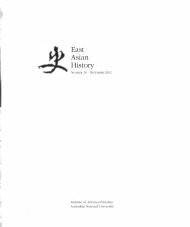Observations from a Film - (Miriam Lang) (PDF ... - East Asian History
Observations from a Film - (Miriam Lang) (PDF ... - East Asian History
Observations from a Film - (Miriam Lang) (PDF ... - East Asian History
- No tags were found...
Create successful ePaper yourself
Turn your PDF publications into a flip-book with our unique Google optimized e-Paper software.
TRADITIONAL MUSICIANS IN CONTEMPORARY CHINA173music had been discontinued in favour of the ever more crowd-pleasingpop music.Although Western pop music has some following in China and is brieflyrepresented in Swan Song by a snatch of "Careless Whispers" by GeorgeMichael of the English pop duo "Wham," who toured China in the mid-1980s,pop music of Chinese origin, either <strong>from</strong> China itself or <strong>from</strong> other parts ofthe Chinese-speaking world, has a much larger audience.63 Most of China'shome-grown pop music is modelled on the pop music of Hong Kong andTaiwan.64 This music fits neatly into Charles Hamm's category of 'Pacific pop'(so-called because of its popularity in Japan, North Korea, the Philippines,Singapore and Indonesia as well as Taiwan, Hong Kong and now China),being characterized by "moderate tempi, texts concerned with romantic love,string-dominated backgrounds ... a singing style reminiscent of OliviaNewton-John and Barry Manilow, and the frequent use of rhythmic patternsderived <strong>from</strong> disco music of the 1970s.,,(i5Another form of pop music which became extremely popular in Chinain the late 1980s was supposedly adapted <strong>from</strong> the folksong style of thenorth-west. Known as 'the north-west wind' (xibei feng ljt)XIJ, thisphenomenon generated considerable comment in music publications aswell as sales of enormous numbers of cassettes. The songs are loosely basedon Chinese-sounding melodies, orchestrated with at least one traditionalChinese instrument as well as the usual instruments of a Western-style popgroup, and matched with lyrics in praise of China's landscape or Chinesepeasant life. This type of music does not appear in Swan Song, as it was firstcatapulted into the national consciousness by the film Red Sorgbum (Honggao!iang tti\\Win 1988, a year after Swan Song appeared. Since that timeit has constituted a significant part of popular culture and indeed of nationalidentity in China. This desire for 'pop music with Chinese characteristics' isanalogous to the wish of Western-style classical composers in China toincorporate Chinese elements into their own music, just as the pianist in thefilm bases her Western-style romantic piano composition on Cantonesemusical sources. From the late 1980s, indigenous rock music (yaogunyinyue Miffff Jf-) has also emerged on the mainland and, although it verymuch follows the styles of American stadium rock and pop-metal, practitionerssuch as CuiJian •• have often asserted the distinctive Chineseness of theirmusic.Along with changes in musical preferences, there has also been a changein people's listening experiences as live performances have gradually givenway to recorded music-perhaps a natural result of improved livingstandards and of the increasing availability and affordability of radios andtape recorders, and, more recently, compact discs, karaoke machines andlaser discs. This change is charted in the film, which begins with music beingperformed in an informal indigenous setting in the community and ends witha televised performance in a Western-style concert hall. In Yang Xiaoxun'ssurvey, respondents were asked to indicate where they heard their preferredmusic. Almost 60% of respondents replied "tape or phonograph," 15.7%63 Yang Xiaoxun's sUIVey shows a relativelysmall margin of popularity for Hong Kongand Taiwan (Gang-Tai i!fi) PoP music; Isuspect that these statistics may have changeddramatically with the increased exposure ofHong Kong and Taiwan singers on themainland in the time since the sUIVey wasconducted. Respondents were asked to indicateall of the kinds of music which theyliked <strong>from</strong> the following list: Hong Kong!Taiwan POP songs, mainland POP songs,Taiwan student songs, 'foreign' POP songs,'foreign' POP instrumental, mainland songs<strong>from</strong> the 19305, and folk songs or traditionalopera. 685 respondents said they liked POPmusic <strong>from</strong> Hong Kong and Taiwan; 667liked mainland POP music; 599 liked Taiwanstudent songs; 592 liked foreign POP music;516 liked foreign POP instrumental; 411liked the Chinese songs of the 19305 and 366liked folk songs and traditional opera. Matchingthese preferences with respondents'occupations, Yang found that Gang-Tai musicwas most popular among secondary anduniversity students; mainland pop musicwas most popular among private businesspeopleand 'workers', and foreign popmusic was most popular with people whoworked in the arts (Yang Xiaoxun, Dissemination,p.ll 0). There is ample evidenceof the enormous popularity of pop stars<strong>from</strong> Hong Kong and Taiwan among youngpeople in China in the early 19905; onerecent article discusses the popularity ofvarious Hong Kong singers and the intenseemotional involvement of their young fanswho feel that, unlike their mainland counterparts,Hong Kong and Taiwanese singersexpress genuine, sincere feeling as theysing, striking a chord with their own emotions (the mainland counter-example beingLin Yilian #flt!, singer of the 1986--87patriotic hit song "Shiwu de yueliang" + .litJe.J}HE [The light of the full moon], who theysay lacks feeling in her performance). Theauthor also notes his or her surprise at hearingyoung people in various parts of Chinasinging along with their heroes in Cantonese(Wang ]ue, "Chongbai Gang-Tai mingxingde fashaoyou" [Adoring fans of Hong Kongand Taiwan stars], Dongxiang 90 (Feb.1993): 24-5.64 This music is sometimes termed 'Cantopop' for its origins in Hong Kong; the termis not entirely accurate as the influence ofTaiwan pop music has been equally strong.65 Hamm, "Music and radio," p.17. Pacificpop's inroads into China began in the lOVER
















